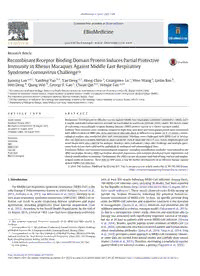
2015 Recombinant Receptor Binding Domain Protein Induces Partial Protective Immunity in Rhesus Macaques Against Middle E PDF
Preview 2015 Recombinant Receptor Binding Domain Protein Induces Partial Protective Immunity in Rhesus Macaques Against Middle E
Research Article Recombinant Receptor Binding Domain Protein Induces Partial Protective Immunity in Rhesus Macaques Against Middle East Respiratory Syndrome Coronavirus Challenge☆ Jiaming Lan a,d,1, Yanfeng Yao b,1, Yao Deng a,1, Hong Chen a, Guangwen Lu c, Wen Wang a, Linlin Bao b, Wei Deng b, Qiang Wei b, George F. Gao c, Chuan Qin b,⁎, Wenjie Tan a,⁎⁎ a Key Laboratory of Medical Virology, Ministry of Health, National Institute for Viral Disease Control and Prevention, China CDC, Beijing 102206, China b Institute of Laboratory Animal Sciences, Chinese Academy of Medical Sciences (CAMS) & Comparative Medicine Center, Peking Union Medical Collage (PUMC), Key Laboratory of Human Disease Comparative Medicine, Ministry of Health, Beijing, China c CAS Key Laboratory of Pathogenic Microbiology and Immunology, Institute of Microbiology, Chinese Academy of Sciences, Beijing 100101, China d Department of Pathogenic Biology, Hebei Medical University, Shijiazhuang 050017, China a b s t r a c t a r t i c l e i n f o Article history: Received 24 June 2015 Received in revised form 16 August 2015 Accepted 17 August 2015 Available online 18 August 2015 Keywords: Immunity RBD MERS-CoV Vaccine Protection Rhesus macaque Background: Development an effective vaccine against Middle East respiratory syndrome coronavirus (MERS-CoV) is urgent and limited information is available on vaccination in nonhuman primate (NHP) model. We herein report of evaluating a recombinant receptor-binding domain (rRBD) protein vaccine in a rhesus macaque model. Methods: Nine monkeys were randomly assigned to high-dose, low-dose and mock groups,which were immunized with different doses of rRBD plus alum adjuvant or adjuvant alone at different time points (0, 8, 25 weeks). Immu- nological analysis was conducted after each immunisation. Monkeys were challenged with MERS-CoV at 14 days after the final immunisation followed by observation for clinical signs and chest X-rays. Nasal, oropharyngeal and rectal swabs were also collected for analyses. Monkeys were euthanized 3 days after challenge and multiple speci- mens from tissues were collected for pathological, virological and immunological tests. Conclusion: Robust and sustained immunological responses (including neutralisation antibody) were elicited by the rRBD vaccination. Besides, rRBD vaccination alleviated pneumonia with evidence of reduced tissue impairment and clinical manifestation in monkeys. Furthermore, the rRBD vaccine decreased viral load of lung, trachea and oropha- ryngeal swabs of monkeys. These data in NHP paves a way for further development of an effective human vaccine against MERS-CoV infection. © 2015 The Authors. Published by Elsevier B.V. This is an open access article under the CC BY-NC-ND license (http://creativecommons.org/licenses/by-nc-nd/4.0/). 1. Introduction The Middle East respiratory syndrome coronavirus (MERS-CoV) is the only lineage C betacoronavirus known to infect humans (Annan et al., 2013; Anthony et al., 2013; van Boheemen et al., 2012). Similarly to se- vere acute respiratory syndrome coronavirus (SARS-CoV), MERS-CoV in- fection can result in acute respiratory distress syndrome and organ dysfunction, including progressive renal function impairment (Zaki et al., 2012). According to the World Health Organization, by the end of 12 August 2015, a total of 1401 cases had been laboratory confirmed, with at least 500 deaths following MERS-CoV infection. Among them, 186 MERS-CoV infection cases, including 36 deaths, had been reported by the Republic of Korea (http://www.who.int/csr/don/12-august-2015- mers-saudi-arabia/en/). These recent clustered cases firstly sprang up outside the Arabian Peninsula, indicating the potential human-to- human transmission of MERS-CoV. To date, no specific antiviral drug exists for MERS-CoV infection and supportive treatment is the mainstay of management (Zumla et al., 2015). Ribavirin and interferon alfa-2b exhibited potential in a rhesus macaque model (Falzarano et al., 2013a, b), but in a retrospective cohort study, ribavirin and interferon alfa-2a therapy was associated with significantly improved survival at 14 days, but not at 28 days in patients with severe MERS-CoV infection (Omrani et al., 2014). Besides, specific peptide fusion inhibitors of MERS-CoV (Lu et al., 2014), convalescent sera from recovered patient and human mono- clonal neutralising antibodies (Jiang et al., 2014; Tang et al., 2014; Ying et al., 2014) provided a novel approach to MERS-CoV treatment. Howev- er, more data are needed from animal studies and carefully done clinical studies (Zumla et al., 2015). Therefore, developing a prophylactic vaccine against MERS-CoV infection remains a priority (Papaneri et al., 2015). EBioMedicine 2 (2015) 1438–1446 ☆ One sentence summary: Protective immunity of the MERS-CoV RBD vaccine in monkeys. ⁎ Correspondence to: C. Qin, Institute of Laboratory Animal Sciences, Chinese Academy of Medical Sciences, No. 5, Panjiayuan Nanli, Chaoyang District, Beijing, China. ⁎⁎ Correspondence to: W. Tan, Key Laboratory of Medical Virology, Ministry of Health, National Institute for Viral Disease Control and Prevention, China CDC, 155 Changbai Road, ChangPing District, Beijing 102206, China. E-mail addresses:
